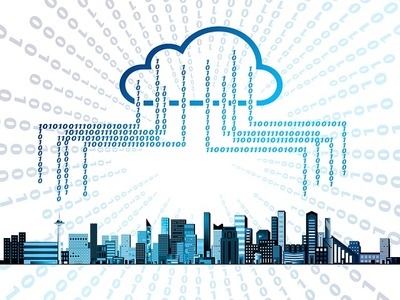After The Cloud, Edge Computing Drives Data Center Development

Edge Computing is growing very fast and requires new technical solutions from small or micro-data centers to take advantage of the advantages of this local data processing. Cloud computing or cloud computing has become in a few years one of the mainstays of enterprise IT departments that have gradually transferred their data centers to colocation, hosted private cloud or public cloud environments. The private cloud is operated by a single company or hosted by a provider and accessible to users via secure networks
In recent years, the “cloud” has been an essential part of the digital transformation for businesses as they continue to migrate their workload to the cloud with a hybrid or multi-cloud architecture. Digital transformation is happening all over our society, economy and various industries. The higher it is it gets more data necessary to thrive. Real-time data is particularly valuable allowing for different entities – including businesses – to respond faster and smarter.
The public cloud is a structure managed by a third-party provider to which multiple users can access via the Internet. In less than ten years, the cloud has become one of the main supports of IT services and companies continue to outsource their data to these cloud solutions. Today, in France, over 55% of workloads are outsourced. For the past five years, we have seen the development of increasingly large cloud facilities to “Hyperscale” sites such as those of the Web giants (Amazon, Microsoft, Google, etc.)
At the same time, more and more data are generated at the periphery of the network, requiring treatment of this data closer to equipment and users: this is the goal of the Edge Computing, a trend that is accelerating. because of new applications and new requirements. Edge Computing powered by IoT, Artificial Intelligence, 5G or 3D For these fast-growing technologies such as IoT, AI or emerging applications such as autonomous vehicles or virtual reality, it is difficult to host/process the data produced in very large quantities in centralized infrastructures: it is necessary to relocate computation or storage tasks closer to the devices and users. “The Internet of Things and more generally the Internet of Everything (IoE) involves the wireless connection of devices, systems, and services to the Internet, from the” Machine to Machine “connection to smart grids to smart cities. who owns these innovations to bring new services?
However, the exponential mass of data generated, compiled with data created daily by billions of humans, brings new challenges in terms of storage, processing, and analysis, strongly impacting server and network infrastructures. In a factory, for a machine to dialogue with another machine, you do not have to go through a data center on the other side. Connected objects that will be more numerous:
“In 2014, about 14 billion devices were connected worldwide. In 2020, there will be 50 billion (source Cisco). Centralized data processing is not always suitable, for example, due to latency.
IoT applications, therefore, require that these data be processed locally using micro data centers. All stakeholders in IoT, public authorities, research or finance will be strongly impacted by these solutions. Basically, we can define two layers supporting the IoT: the central layer, with large data analysis, and the decentralized layer (near), with a fast analysis. Edge Computing is becoming a necessary addition to the cloud: “In such an approach, the central information system in the cloud remains the reference: Local mini-datacenters become a granular extension, able to relieve the central system. In the case of IoT, for example, Edge computing can collect all the data and transmit centrally only monitoring information at defined intervals, or notable data (to trace an alert, for example).
This, in fact, limits the flow of data over networks and storage in the cloud. An expert said, in terms of artificial intelligence and deep learning, the design and learning of the model can be done on the Edge Computing infrastructure, especially when it is needed. to rely on contextualized data. The central IS in the Cloud – and its possible additional computing power – is then used only for the improvement of the model, before being redeployed locally. In this case, the main interest is to switch part of the “compute” network periphery and put the models closer to reality.
Opposing the centralized model of the Cloud and the distributed one of Edge Computing does not make sense. However, the approach of the periphery of the network requires rethinking its architectures, its methodologies and of course its skills. Micro-datacenters for this distributed cloud at the network’s border. The solution is to supplement large data centers with smaller data centers, located closer to the application or the need to unclog the information superhighway, manage effectively real-time capabilities and reduce latency. This latter parameter is important for applications such as the autonomous vehicle or machine-to-machine exchanges of Industry 4.0, but also medical applications and all those involving safety and human life.
Cloud Data security is also an important parameter, which militates for the installation of these data centers on the customer’s site also for industrial control-command solutions, our customers are sensitive to data security and choose the ones that go into the cloud and those that stay in the factory: process data or manufacturing secrets. Our Secure Data Center (SEDC) prefabricated data center solution meets this need for the industrial sector, for a closer installation of the process: IP55 protection, fire protection (detection + extinction), equipped with 2 2N inverters and tested in the factory. But this solution is not limited to the industry, it also concerns shopping centers or hospitals and more generally the renovation of computer rooms scattered in a factory or university. The microstructure must have the same level of security and availability that is expected for the largest data centers used by the giants of the Web. Today it is possible: redundancy, monitoring, and remote control, mapping of IT assets.
These micro-datacenters can look like large enclosures up to large cabinets such as our Smart Bunker, which can be operated directly in the factory. These solutions are more expensive than a simple server, but the advantage is to be able to deploy a real infrastructure with high-security mechanisms and a ready-to-use technical package. For data-intensive and data-processing sectors such as retail or telecommunications, they are the ideal option for private cloud development.
This report captures the perceptions of more than 800 data center professionals around the world and shows market trends, including a very strong Edge Computing performance. To meet the needs and specifications of this market, manufacturers have developed a modular offer, easy to implement, tested in the factory and available in 2 or 3 weeks.
Solutions to meet a market development that will accelerate further with the arrival of 5G and its technical innovations, which will stimulate the demand for Edge Computing and amplify the benefits that will result.
